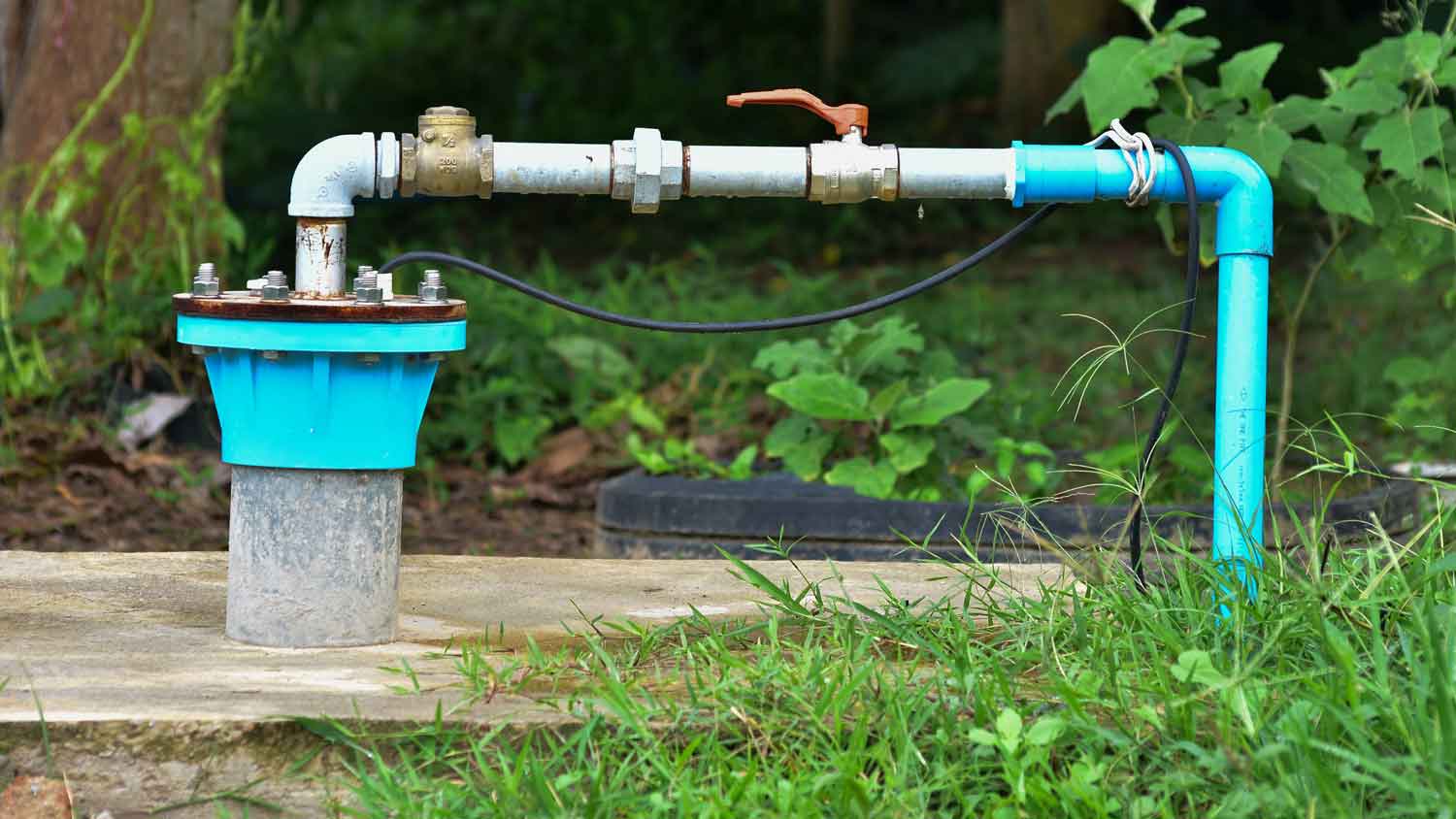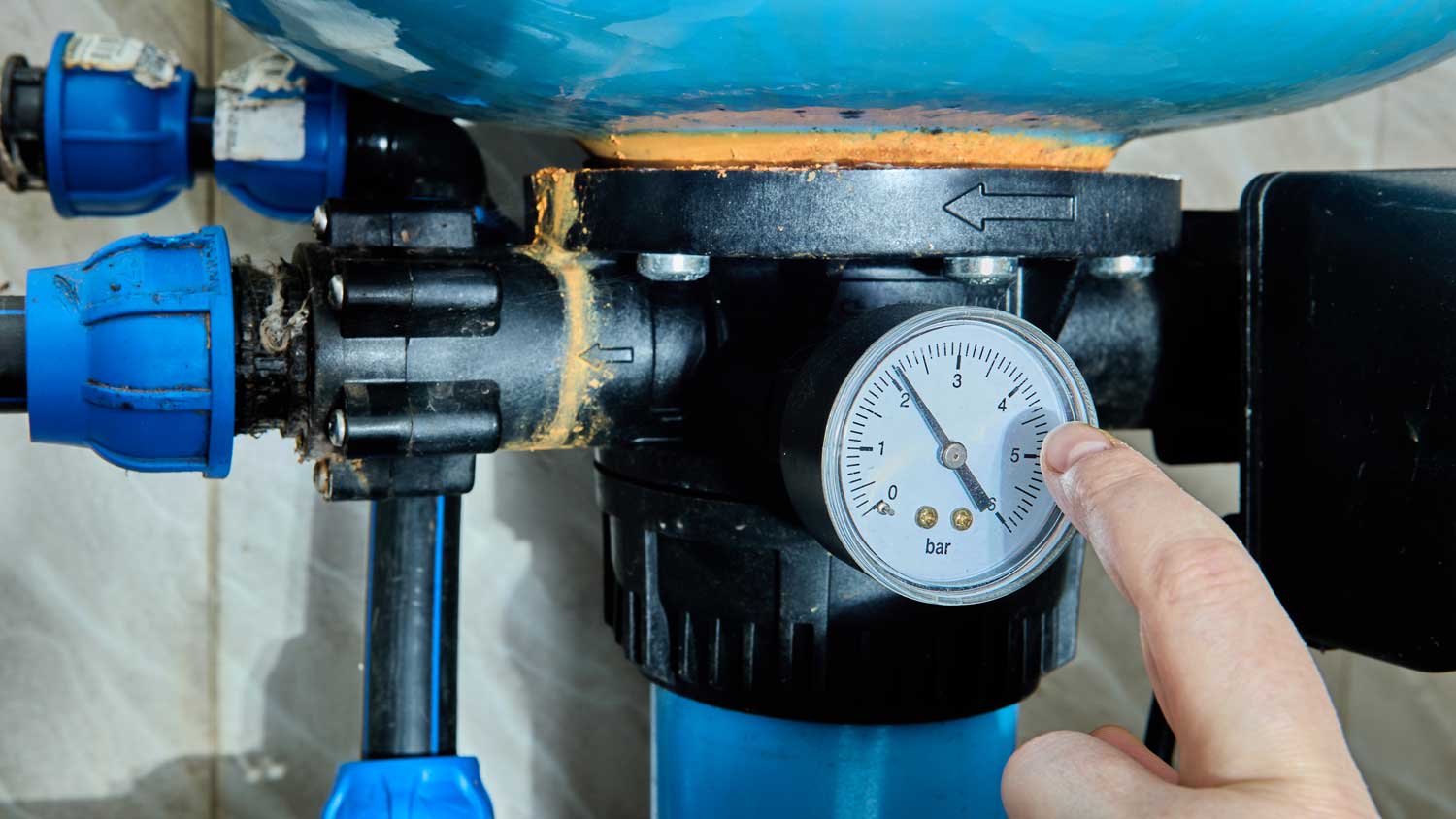How Much Pressure Should a Well Pump Have?
Shower in peace with the right well pump pressure


A well system includes a well pump, pressure tank, and pressure switch.
Well pump pressure is measured in pounds per square inch (psi).
Most well pumps are set to 40/60 psi.
You can adjust your pump and tank to set your own pressure.
Your well pump keeps water flowing smoothly through your home. But if you’re experiencing a weak shower or a spitting tap, your well pump pressure may not be on the right setting. Most well pump pressure tanks should be set to 40/60 psi. Explore how much pressure your well pump should have to work properly as well as some simple guidelines for setting custom water pressures while still keeping your pump system running efficiently.
Parts of a Well System

Your well system is made up of three main components that move water from the well into your home: the well pump, the pressure switch, and the pressure tank.
Well Pump
The well pump is a pump and motor system that pushes or pulls water up from the well and into the pressure tank. A well pump can sit either at the top of the well and pull water up or rest under the water and push water upward.
Most residential wells use a jet pump or a submersible pump. Well pumps that sit at the top are often jet pumps and can be used for shallow wells (up to 25 feet deep). Deeper wells generally use a submersible pump.
Pressure Tank
The pressure tank stores well water in your house until a fixture like a tap or toilet is activated. Water then flows from the pressure tank to the water fixture, causing pressure to drop inside the pressure tank.
Low pressure in the water tank signals the pressure switch, which activates the well pump to turn on and refill the pressure tank.
Pressure Switch
The pressure switch is the intermediary between the pressure tank and the well pump. By only turning on the well pump when the well tank hits the lower pressure threshold, the pressure switch helps boost efficiency and prolong the life of the well pump.
How to Read Well Pump Pressure
Well pump pressure is measured in psi, or pounds per square inch. When you look at your well pressure switch, it will show two numbers, like 30/40 or 40/60. These are the cut-in and cut-out pressures.
The lowest number is the cut-in pressure or the low pressure that triggers the pump to turn on and fill up the well tank. The higher number is the cut-out pressure—when the well pressure tank hits this pressure, the pressure switch signals the pump to turn off.
Well pressure tanks are set at 2 psi below the cut-in pressure. So for a well pressure switch set at 30/50, the well pressure tank will be set at 28. This measures the pressure inside the well tank when it is empty or nearly empty.
What Pressure Should Your Well Pump Have?

Most well pressure switches are set at either 30/50 psi or 40/60 psi.
30/50 psi will give you lower water pressure
40/60 psi delivers higher strength pressure
While going outside these settings won’t necessarily hurt your pump, this range tends to be the safest to keep a well pump running efficiently. Going lower than 30 for cut-in pressure can lead to low water pressure while going higher than 60 for cut-out pressure puts a lot of strain on your well pump and can lead to a costly well pump replacement.
Since there’s not one perfect setting for your well pump pressure, you can follow the general rules below to ensure that your well pump works efficiently after you adjust the pressure settings.
Use the Factory Settings
Before you make any adjustments it’s a good idea to check your pressure switch’s factory settings so you know where your specific pump was set before you change it. If you don’t know the factory settings because your pump has already been adjusted, it’s usually safe to pick one of the common pressure settings above, based on your personal water pressure preferences.
However, if you’re having trouble resetting the pressure switch or you don’t know which setting to pick, a local well pump contractor near you can help you with a well inspection to troubleshoot these issues.
Keep a 20-PSI Differential
With the standard 30/50 and 40/60 psi setting, it’s important to notice that both have a difference of 20 psi between the cut-in and cut-out numbers. Maintaining this difference protects your pump, even if you change the pressure settings for your well pump outside of these common settings.
If there’s too big a gap between the cut-in and cut-out pressures, your pump runs the risk of constant cycling. This can cause the motor to burn out and is one of the fastest ways to break a well pump.
If the gap between cut-in and cut-out pressure is too small, the pressure tank won’t fill all the way and you may run out of water.
It’s best to adjust in small increments to get the water pressure you want. As long as you stick to a 20 psi differential, you’re free to try different pressure settings until you find one that feels just right. For example, if your well pressure switch is currently set at 30/50 psi but you’d like a little more well water pressure, adjusting it to 35/55 psi can deliver slightly higher water pressure without hurting your well pump system.
Remember to Adjust the Pressure Tank
If you’ve decided to adjust your well pressure switch, it’s important to adjust your well pressure tank’s psi to match. Leaving the pressure tank at a psi that doesn’t align with the pressure switch may cause your home to be without water or lead to major issues and the need for a new well pressure tank.
Your well pressure tank should always sit at 2 psi below the cut-in pressure, so if you changed your switch from 30/50 psi to 35/55 psi, your new well pressure tank setting should be 33 psi.
Frequently Asked Questions
For the most part, choosing between 30/50 psi and 40/60 psi is based on your water-pressure preference. However, it can also depend a little bit on your house—if you have older plumbing, a lower water pressure can be easier on the pipes (and a bit more gentle on your well pump).
The lower 30/50 pressure is usually enough for a single-story home, but you may want 40/60 if you have multiple stories, as the extra pressure helps water flow smoothly up to the second floor.
Yes, you can adjust your well pump pressure relatively easily by yourself. You’ll need to remove the cover from your pressure switch and adjust a nut that controls cut-in pressure. Learn more about how to adjust a well pump pressure switch with a step-by-step guide to setting your water pressure.





- How To Set Up a Well Pump and Pressure Tank for Your Home
- How to Choose the Right Pressure for Your Well Tank
- How To Increase the Water Pressure From Your Well
- How To Get More Pressure From Your Well: Everything You Need To Know
- When and How To Test Your Well Pressure Tank
- Well Water Stopped Working? Here Are 5 Troubleshooting Causes and Solutions
- Common Well Pump Pressure Switch Problems and How To Fix Them
- How to Check Your Well Pump: Troubleshooting and Fixes
- How To Install a Well Pressure Tank the Right Way
- 9 Tips to Help Increase the Water Pressure in Your House










